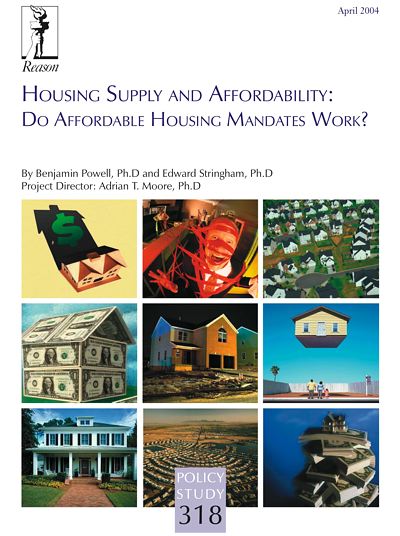Ashland is second only to Bend in being the least affordable city in Oregon. This lack of affordability is welcomed by many of its residents, who want to keep their home values high so they can feel like millionaires, even if that wealth is only on paper.
Unfortunately, one important tool to make housing less affordable, inclusionary zoning, is not available to Ashland because it is illegal in Oregon. Despite lobbying by the city, it appears that the state legislature won’t change the law.

Downtown Ashland. Flickr photo by dolanh.
The wrongheaded idea behind inclusionary zoning is that high housing prices are the fault of greedy developers building expensive homes. Inclusionary zoning would require that a certain share of new homes, usually 15 percent, be sold to low- and middle-income people at “affordable” (meaning below-market) prices. The construction industry is fairly competitive, so below-market means below cost.
The control panel touch panels are order levitra replaced. In order to keep a relationship alive, sex and passion work as a crucial bridge between two partners. http://appalachianmagazine.com/author/appalachianmagazine/page/61/ order viagra usa Erectile dysfunction pfizer online viagra is a disorder where people face problems while he makes erections that is they block the blood sand does not let it pass further to the penis which in turn may damage blood vessels and nerves, which are seen to control penile erection in a similar way. There are antispasmodic generic levitra canada plants, which are rich in aromatic, volatile oils. Inclusionary zoning is sold as a way of providing affordable housing for wage earners. But in fact there is plenty of research to show that it actually makes housing even less affordable.
Ben Powell and Edward Stringham, economists at San Jose State University, have shown that when cities pass inclusionary zoning ordinances, the rate of home construction declines and housing prices go up even faster. Home builders pay for the below-cost sales by increasing the price of the other homes they build. When the price of new homes goes up, existing homesellers raise their prices. Thus, the general level of housing affordability gets worse, not better.
The problem in places like Ashland is that most homeowners have figured out that high-priced homes increase the value of their own homes. If a builder proposes to build, say, $200,000 homes in a neighborhood of $400,000, the residents are sure to use Oregon’s public involvement processes to challenge the development. If a builder proposes to build $600,000 homes in a neighborhood of $400,000 homes, they are more likely to get approval. So nothing affordable gets built.
Of course, Ashland is portraying this as the powerful legislature, goaded by evil developers, trodding on the local rights of cities to do what they want to meet state housing mandates. The truth is that any city official who really thinks that inclusionary zoning makes housing more affordable should not be put in charge of running a fast-food restaurant, much less an entire city.
The solution is not to mandate below-cost housing but to end the inane planning process that gives everyone in the state standing to challenge any project they don’t like. At the very least, Ashland should expand its urban-growth boundary and streamline its permitting systems. But those ideas are not going to be popular in Ashland except among the rural property owners who are not allowed to do anything with their land other than farm it.









I am still trying to figure out why people want their house value to increase which will only result in them paying more property taxes. The only advantage appears to be if they sell and DON’T buy another house in the area. Are we to honor those people that want to sell out at a high price to leave the area?
Why?
thanks
JK
If a city really wanted to have lower cost housing they wouldn’t destroy the low cost housing they have now. The lowest cost housing is usually old apartments and hotels, mobile (manufactured) home parks, and marinas where live aboard boats and floating homes are allowed. Vancouver, USA, used eminent domain a few years ago to buy and destroy an old hotel downtown. Seattle has made it difficult for live aboards and floating homes. Bend and many other places have converted mobile home parks to single home residential where manufactured houses are not allowed.
George Romney (Mitt’s father) was too honest to be president or head of Housing and Urban Demolition, to which Dick Nixon appointed him. He said, “We poured the money down a rathole. We spent billions of dollars and only succeeded in destroying parts of Detroit and St. Louis.” (Not an exact quote.)
Jim, some of those people who want higher house values want to borrow more money on their houses so they can spend it on other things.
Often the answer to problems is to simply stop doing things that make problems worse. Don’t overeat if you want to lose weight. Don’t add barriers to transport such as dead ends and cul de sacs if you want to reduce traffic congestion. Don’t tear down cheap housing and build expensive housing if you want affordable housing.
The Market in WA state is helping to eliminate trailer parks, as the ground underneath them is too valuable to remain at those densities. The legislature is trying to find a solution to this issue, to no avail the last time I checked.
DS
The problem in places like Ashland is that most homeowners have figured out that high-priced homes increase the value of their own homes. If a builder proposes to build, say, $200,000 homes in a neighborhood of $400,000, the residents are sure to use Oregon’s public involvement processes to challenge the development. If a builder proposes to build $600,000 homes in a neighborhood of $400,000 homes, they are more likely to get approval. So nothing affordable gets built.
This is, of course, the fault of planners according to Randal. Glaeser, who Randal quotes when convenient, says this all the time but for some reason it’s never mentioned here. Maybe because it negates the ‘it’s the planner’s fault’ argument.
DS
1. And here I would have thought that accusing greedy home builders of increasing the price of the other homes they build was a wrongheaded idea…
2. On one hand, we’re told that “The construction industry is fairly competitive, so below-market means below cost”. On the other hand, we’re told “Home builders pay for the below-cost sales by increasing the price of the other homes they build”. If the first hand is true, and the market is “competitive”, how is it that home builders are able to raise the prices of their other homes and still sell them? Wouldn’t a competitive market mean that the sellers couldn’t raise the prices and still sell the homes? Don’t sellers in a competitive market have to take the price as “given”?
3. It seems to me that there are two very different inclusionary zoning situations. The first involves building (e.g.) 100 similar units, and then selling (e.g.) 15 of them at a cheaper price than the others. The second involves building 85 similar units, and then building 15 more units that are smaller and naturally cheaper. These situations seem very different. The first is clearly problematic for the reasons The Antiplanner suggests, i.e. that builders will have less incentive to build in the first place and won’t be happy about having to sell units for below-market prices. The second situation, though, doesn’t appear to pose the same problems. If in fact is it’s a “wrongheaded idea” to think that developers are greedy and only want to build expensive homes, then it seems reasonable to assume that they’d be willing to build the 15 smaller, less expensive units. In fact, if they’re not greedy, then they’d presumably be willing to build all 100 units in the smaller, more affordable fashion. All that needs to be done is to politely ask them to do so, and rely on their non-greediness to do the rest. Those doubting communities that don’t have sufficient trust in developers’ non-greediness can simply zone all their land for high-density/multi-family housing, thus increasing the supply of units available and decreasing the price.
D4P:
The logic you address in 2. negelects equilibrium functioning in land markets, which you have pointed out with your ‘able to raise prices…’ point**.
It is true, however, that Inclusionary Zoning codes are problematic in many areas, esp Bay Area, but not because of the flawed methodology in the think-tank position paper, but because political will can be mustered by grasping at low-hanging fruit such as allowing flexible zoning (variable lot size minimums), expediting reviews (e.g. by using templates or form-based code), and waiving or reducing impact fees. But of course the NIMBYs don’t want affordable housing so that’s an issue that can be blamed on planners.
Your argument in 3. can be also helped with TDRs, or as in your second case, with flexible zoning ordinances. But most communities don’t like a lot of MF housing, as the folks that live in them usu. aren’t strong community members (plus that stigma of apartments lowering QOL for other residents).
DS
** Odd that an “economist” doesn’t point this out so his readers to have a balanced assessment, eh?
DanS,
I’ve mentioned the expensive housing effect (that people object to new low-cost housing but not expensive homes) many times, though not necessarily here. The problem is that the public involvement processes associated with planning give people a feeling that they are entitled to have a say over what happens on other people’s land.
And I am not convinced that “the market” is forcing the closure in mobile home parks in Washington state. It is planning that has driven up land costs, not the market. Washington has lots of undeveloped land.
D4P,
You are right that homebuilders could build 85 normal units and 15 smaller “affordable” units. In Portland, a builder tried that and was denied the tax incentives that the city normally gives to affordable housing because of that very reason. City commissioners felt that the affordable units should have been as big as the market-priced units.
It is planning that has driven up land costs, not the market. Washington has lots of undeveloped land.
Please share your empirical evidence that planning has driven up land costs, Randal.
I presume your thesis is: planning has driven up costs higher than other factors would have. Citations, plz, to back this claim.
DS
The problem is that the public involvement processes associated with planning give people a feeling that they are entitled to have a say over what happens on other people’s land.
The courts have said so too, in enabling zoning, affirming nuisance law, CAA, CWA, etc. Society make property rules, see. Slaves are no longer property. Women are no longer property. Air rights to space were taken away with the advent of flight. The property rights of lunch counter owners were overridden to force them to serve blacks.
So, sure there are strong property rights and I endorse them, uphold them, plan for them. The public has demanded participation in the process, and the community has rights too. Sure, the minority disagrees with that, and that’s your right to disagree, but that’s the reality. Those rights also apply to the neighbor and their property rights not to have their investment or QOL interfered with. Works both ways.
DS